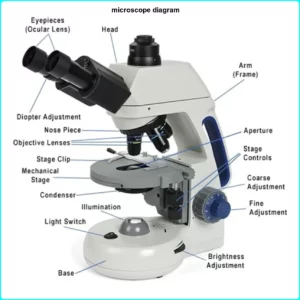What is Microscope?
A microscope is an instrument used to magnify small objects. Some of these microscopes can also be used to observe an object at the cellular level, allowing scientists to see the shape of a cell, its nucleus, mitochondria, and other organelles.
While the modern microscope consists of many parts, the most important of all is its lens. It is through the lens of a microscope that the image of an object can be magnified and seen in detail.
A simple optical microscope magnifies the image of how light enters the eye by using a convex lens, where both sides of the lens are curved outward.
When light reflects off an object being viewed under a microscope and passes through the lens, it is bent towards the eye. This makes the object appear larger than it actually is.
What is meant by microscope
The word “microscope” comes from the Latin word “microscopium,” which is derived from the Greek words “micros,” meaning “small,” and “scopin,” meaning “to see.”

Article About:- Health & fitness
Article About:- Medical Technology
Article About:-Sports
What are the Different Microscope Types and Their Uses?
There are many types of microscopes and each of them solves unique problems. Information is provided about the different microscop types, along with applications for each microscop, as well as who uses each instrument.
Below each detail of the microscope and its uses is an image that has been captured while using that particular microscope. What are the Different Microscope Types and Their Uses
What is Compound Microscope
A compound microscope is defined as a type of microscope that has more than one lens. It consists of a lens and a combination of two optical parts known as an objective lens and an eyepiece or ocular lens.
The magnifying power of a compound microscope is shown as.

where,
D indicates the minimum distance of clear vision.
L denotes the length of the microscope tube
F0 denotes the focal length of the objective lens
fe denotes the focal length of the eyepiece
Working principle of compound microscop
The working principle of compound microscop is such that the combination of lenses increases the magnification of the sample according to the size. The sample is first viewed as the primary image in the tube and then viewed in the eyepiece.
Applications of Compound Microscop
The study of bacteria and viruses is possible with the help of this microscope.
A compound microscope is used in forensic laboratories.
It is also used in metallurgy.
What is Stereo Microscope
It can be defined as a type of microscop that provides a three-dimensional view of a specimen. It is also known as dissecting microscop.
In this microscopes, there are separate objective lenses and eyepieces such that there are two separate optical paths for each eye.
Working principle of stereo microscope
This microscope works on the light reflected from the sample. The magnification of the microscop is at low power and hence it is suitable for magnifying opaque objects.
It is suitable for thick and solid samples as it uses the reflected light from the sample. The magnification of a stereo microscope is between 20x and 50x.
Applications of Stereo Microscopes
With the help of this microscop, it is possible to examine historical coins and artifacts.
It is used in microsurgery.
Using this microscope it became easier to see the crystals.
What is Simple Microscope
This microscope is defined as the type of microscope that uses a single lens to magnify the sample. A simple microscop is a convex lens with a short focal length. The magnifying power of an ordinary microscop is given as.

m = 1 + d / f
where,
D shows least distinct vision
F denotes the focal length of the convex lens
Working principle of simple microscope
The working principle of the ordinary microscope is that when a specimen is placed within the focus of the microscope, a virtual, erect and magnified image is obtained at the shortest distance of vision distinct from the eye placed on the lens.
Simple Microscope Application
It is used by watchmakers because they can see a magnified image of small parts.
It is also used by jewelers to obtain a magnified image of finer pieces of jewelry.
Most educational institutions such as schools and colleges use a simple microscop in their laboratories.
Dermatologists use simple microscopes to identify various skin diseases.
What is Inverted Microscope
These microscops are available as biological inverted microscops or metallurgical inverted microscopes. Biological inverted microscops provide magnifications of 40x, 100x and sometimes more than 200x and 400x.

These biological inverted microscops are used to view living specimens that are in petri dishes. An inverted microscop allows the user to place the Petri dish on a flat platform with the objective lens located at the bottom of the stage.
Inverted microscops are used for in-vitro fertilization, live cell imaging, developmental biology, cell biology, neuroscience, and microbiology. Inverted microscops are often used in research to analyze and study tissues and cells, and especially living cells.
Metallurgical inverted microscops are used to examine large parts at high magnification for fractures or defects. They are similar to biological inverted microscops in the magnification they provide but have a primary difference that the samples are not placed in a Petri dish,
but rather a smooth side of the sample is drawn so that it can lie flat on the stage. This smooth specimen is polished and is sometimes called a puck.
What is Metallurgical Microscope
These microscops are high powered microscops designed to view specimens that do not allow light to pass through them. It shines reflected light down through an objective lens providing magnifications of 50x, 100x, 200x, and sometimes 500x.
Metallurgical microscops are used to examine micron level cracks in metals in very thin layers of coatings such as paint, and grain size.
Metallurgical microscops are used by the aerospace industry, the automobile manufacturing industry, and companies analyzing metal structures, composites, glass, wood, ceramics, polymers and liquid crystals.
This image of a piece of metal with scratches on it was captured under a metallurgical microscop at 100x magnification.
What is Polarizing Microscope
These microscops use polarized light with transmitted and, or reflected light, to examine chemicals, rocks, and minerals. Polarizing microscops are used on a daily basis by geologists, petrologists, chemists, and the pharmaceutical industry.
Polarizing microscops have both a polarizer and an analyzer. The polarizer allows only certain light waves to pass through it. The analyzer determines the amount of light and the direction of light that illuminates the sample.
Polarizers basically focus different wavelengths of light on the same plane. This function is perfect for allowing the microscop to view binocular material.
What is Scanning Probe Microscope
This microscop is defined as the type of microscop that finds applications in industries where samples are examined at nanoscale levels. The properties of a sample, its reaction time and its behavior when excited are studied with the help of a scanning probe microscop.
Working Principle of Scanning Probe Microscope
It consists of a probe tip that is mounted on the end of a cantilever. The tip is so sharp that it can precisely and precisely move each atom across the surface of the sample being scanned.
The tip is held close to the surface of the sample, such that the cantilever experiences deflection due to forces. This deflection distance is measured by the laser. After scanning the final image is obtained on the computer.
Application of Scanning Probe Microscope
This microscop is used to study various properties of the sample like electrical properties.
This microscop is used to study the magnetic properties of the sample.
With the help of this microscop, information is transferred on the sample
Advantage of microscope
1.) Microscop-assisted A major tool in modern cell biology, several features make light microscopy ideal for imaging biology in living cells.
2.) Easy to Operate Simple to set up and can be operated by anyone with minimal training and knowledge, portable microscops are easy for any user.
3.) These microscops are much cheaper than other microscops including electron microscop. It is a good tool for low budget schools, colleges or research projects.
4.) They are usually inexpensive. Light microscops are useful in developing countries, especially outside wealthy urban centres, government institutions and universities.
5.) This microscop is suitable for identifying disease-causing organisms in an outbreak in a short period of time.
5.) This microscop is an inverted bright field and fluorescence microscop that can magnify an image up to 1000x. It is especially used to detect Mycobacterium tuberculosis, a common disease from sputum smears in undeveloped communities .
6.) Microscops are small, they do not take up much space in the laboratory, so they can be used in space microscops.
7.) Being lightweight and portable, these microscop can be deployed in small areas at minimal cost and effort. It is especially ideal for field studies that involve setting up mobile laboratories in outbreak areas.
8.) The non-destructive nature of light for observation of cellular structures means that living cells are imaged for a longer period of time. Therefore, cell dynamics are effectively studied using these microscops.
Disadvantage of microscope
1.) A light microscop is ideal for viewing some subcellular structures, yet the resolution is relatively low. Observation is limited to structures at lateral distances of less than half the wavelength of light.
At this scale, structures become blurry and hard to identify and even using additional lenses doesn’t do much for improving resolution. Image structures require alternative methods, including super-resolution microscopy and electron microscopy.
Atomic structures and fine details of proteins and nucleic acids are some of the structures that portable microscops cannot see.
2.) These microscopes are unable to provide 3D rendering of structures
3.) Stereo microscopy is used to estimate the depth of the three-dimensional shape. Portable microscopes do not provide in-depth information on three-dimensional structures. Instruments like Scanning Tunneling Microscope and Scanning Electron Microscope are better suited for this.
4.) Some microscops, especially those at the lower end of the cost scale, may come with very low magnification caps (as low as 40x). The lens most commonly used when operating a portable microscope is the 10x, which gives a magnification of 100x when used in conjunction with a 10x ocular lens.
5.) Portable light microscopes are difficult to use in some situations, making it difficult to operate in the dark.
How to use a microscope step by step
1.) Rotate the objective lens so that the longest lens is in the viewing position. Make sure it has room to make it. If necessary reduce the mechanical step to make more space.
2.) Place the slide on the mechanical stage and attach it with the stage clip
Look at the side of the microscop and turn the adjustment knob until the lens is very close to the slide but not touching.
3.) Look through the eyepiece and move the adjustment knob so that the lens moves away from the slide and the image should be in focus. Be careful not to drop the lens in front of the slide as this may damage the lens.
4.) The condenser is adjusted to increase or decrease the light intensity. Usually want the most possible light to see clear. But with low powered objective lenses you may need to dim the light.
5.) The slide can be moved around to center the desired image in the field of view.
6.) Once you have a clear image with a low-power objective, you can switch the objective lens to a higher-powered one. Since they’re small, you don’t need to worry about turning them into the face of the slide and damaging them.
7.) The focus and center of the object you are looking at needs to be adjusted slightly. If you try this and it doesn’t come into focus, leave the lens very close, but don’t touch the slide (to do this look through the microscope, not through the eye piece) and then look when You lift the lens slowly away from the slide then the eyepiece at some point.
8.) When finished viewing the slide, use the adjustment knob to lower the mechanical stage, position the low power lens in the viewing position (in preparation for the next time) and remove the slide.
9.) When using the microscop with a single eyepiece, it is best to keep the other eye open to avoid eye strain. The image is flipped upside down and horizontally when viewed through a microscop.
So while moving it, it appears to move in the opposite direction to the intended purpose. Moving the slide up moves the image down, and moving the slide down moves the right image to the left.
10.) Prepare the slide with a protective coverslip.
11.) Do not touch the glass part in the middle of the lens with your fingers, only the edges. Use special lens paper to clean the lens.
12.) Turn off the microscop when it is not in use. Always keep the microscope covered when not in use.








